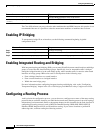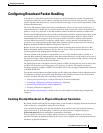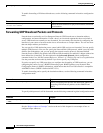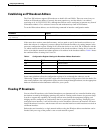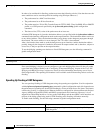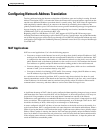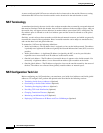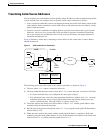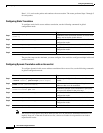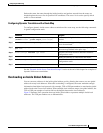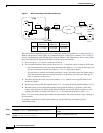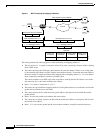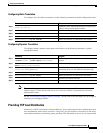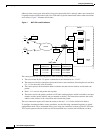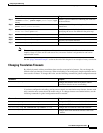
Configuring IP Addressing
Configuring Network Address Translation
IPC-38
Cisco IOS IP Configuration Guide
Host 1.1.1.1 receives the packet and continues the conversation. The router performs Steps 2 through 5
for each packet.
Configuring Static Translation
To configure static inside source address translation, use the following commands in global
configuration mode:
The previous steps are the minimum you must configure. You could also configure multiple inside and
outside interfaces.
Configuring Dynamic Translation with an Access List
To configure dynamic inside source address translation with an access list, use the following commands
in global configuration mode:
Note The access list must permit only those addresses that are to be translated. (Remember that there is an
implicit “deny all” at the end of each access list.) An access list that is too permissive can lead to
unpredictable results.
Command Purpose
Step 1
Router(config)# ip nat inside source static local-ip
global-ip
Establishes static translation between an inside local
address and an inside global address.
Step 2
Router(config)# interface type number
Specifies the inside interface and enters interface
configuration mode.
Step 3
Router(config-if)# ip nat inside
Marks the interface as connected to the inside.
Step 4
Router(config)# interface type number
Specifies the outside interface and enters interface
configuration mode.
Step 5
Router(config-if)# ip nat outside
Marks the interface as connected to the outside.
Command Purpose
Step 1
Router(config)# ip nat pool name start-ip end-ip
{netmask netmask | prefix-length prefix-length}
Defines a pool of global addresses to be allocated as
needed.
Step 2
Router(config)# access-list access-list-number
permit source [source-wildcard]
Defines a standard access list permitting those
addresses that are to be translated.
Step 3
Router(config)# ip nat inside source list
access-list-number pool name
Establishes dynamic source translation, specifying
the access list defined in the prior step.
Step 4
Router(config)# interface type number
Specifies the inside interface and enters interface
configuration mode.
Step 5
Router(config-if)# ip nat inside
Marks the interface as connected to the inside.
Step 6
Router(config)# interface type number
Specifies the outside interface and enters interface
configuration mode.
Step 7
Router(config-if)# ip nat outside
Marks the interface as connected to the outside.



